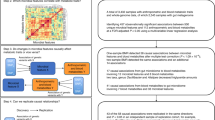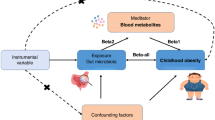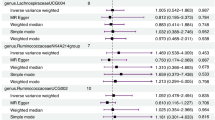Abstract
Background
Previous evidence suggests close relationships between the gut microbiota and short stature, but the causal relationship between them remains unclear. Our study performed Mendelian randomization (MR) analysis to investigate the causal relationships between gut microbiota, blood metabolites, and short stature, and to identify the potential role of blood metabolites as mediators.
Methods
We extracted summary-level data for 119 genera gut microbiota, 309 blood metabolites, and short stature from published genome-wide association studies (GWASs). We applied two-sample MR to infer the causal links, and a two-step MR was employed to quantify the proportion of the effect of gut microbiota on short stature mediated by blood metabolites.
Results
Increased Prevotella9, Alloprevotella, FamilyXIIIAD3011group, 3-(4-hydroxyphenyl) lactate, and cyclo (leu-pro) were potentially associated with higher short stature risk while Parasutterella, Clostridium sensu stricto 1, Roseburia, caffeine, laurate (12:0), and 4-hydroxyhippurate were related to lower short stature risk. Mediation analysis indicated that 4-hydroxyhippurate levels acted as a mediator between Clostridium sensu stricto 1 and short stature, with an indirect effect proportion of 43.03%.
Conclusion
Our study demonstrates the causal relationships among gut microbiota, blood metabolites, and short stature, and computes the proportion of the effect mediated by blood metabolites, provides new insights for studying the gut-bone axis theory in short stature.
Impact
-
Our study used Mendelian randomization to demonstrate a causal relationship between gut microbiota, blood metabolites and short stature and identified a mediating role for metabolites.
-
Current studies on the relationship between gut microbiota and short stature are observational and cannot infer causality, our research provides new evidence for this problem.
-
This is the first Mendelian randomization study of gut microbiota, blood metabolites and short stature, providing new insights into the gut-skeletal axis theory of short stature.
This is a preview of subscription content, access via your institution
Access options
Subscribe to this journal
Receive 14 print issues and online access
$259.00 per year
only $18.50 per issue
Buy this article
- Purchase on SpringerLink
- Instant access to full article PDF
Prices may be subject to local taxes which are calculated during checkout

Similar content being viewed by others
Data availability
Publicly available datasets were analyzed in this study. Gut microbiota: https://mibiogen.gcc.rug.nl/. Metabolites: http://ftp.ebi.ac.uk/pub/databases/gwas/summary_statistics/. Short Stature: https://r9.finngen.fi/. Further inquiries can be directed to the corresponding author.
References
United Nations Children’s Fund (UNICEF), World Health Organization, International Bank for Reconstruction and Development/The World Bank. Levels and trends in child malnutrition: key findings of the 2019 Edition. https://www.unicef.org/reports/joint-child-malnutrition-estimates-levels-and-trends-child-malnutrition-2019 (2019).
Yengo, L. et al. A saturated map of common genetic variants associated with human height. Nature 610, 704–712 (2022).
Inzaghi, E., Reiter, E. & Cianfarani, S. The Challenge of Defining and Investigating the Causes of Idiopathic Short Stature and Finding an Effective Therapy. Horm. Res. Paediatr. 92, 71–83 (2019).
Andrade, N. L. M. et al. Diagnostic yield of a multigene sequencing approach in children classified as idiopathic short stature. Endocr. Connect 11, e220214 (2022).
Jones, H. J., Bourke, C. D., Swann, J. R. & Robertson, R. C. Malnourished Microbes: Host-Microbiome Interactions in Child Undernutrition. Annu. Rev. Nutr. 43, 327–353 (2023).
Wang, S. et al. Early life gut microbiota: Consequences for health and opportunities for prevention. Crit. Rev. Food Sci. Nutr. 64, 5793–5817 (2024).
Villa, C. R., Ward, W. E. & Comelli, E. M. Gut microbiota-bone axis. Crit. Rev. Food Sci. Nutr. 57, 1664–1672 (2017).
Schwarzer, M. et al. Lactobacillus plantarum strain maintains growth of infant mice during chronic undernutrition. Science 351, 854–857 (2016).
Yan, J. et al. Gut microbiota induce IGF-1 and promote bone formation and growth. Proc. Natl Acad. Sci. USA 113, E7554–E7563 (2016).
Bowden, J. & Holmes, M. V. Meta-analysis and Mendelian randomization: A review. Res Synth. Methods 10, 486–496 (2019).
Li, L. et al. Characteristics of Gut Microbiome and Its Metabolites, Short-Chain Fatty Acids, in Children With Idiopathic Short Stature. Front Endocrinol. 13, 890200 (2022).
Miao, J. et al. Characteristics of intestinal microbiota in children with idiopathic short stature: a cross-sectional study. Eur. J. Pediatr. 182, 4537–4546 (2023).
Kurilshikov, A. et al. Large-scale association analyses identify host factors influencing human gut microbiome composition. Nat. Genet. 53, 156–165 (2021).
Shin, S. Y. et al. An atlas of genetic influences on human blood metabolites. Nat. Genet. 46, 543–550 (2014).
Kurki, M. I. et al. FinnGen provides genetic insights from a well-phenotyped isolated population. Nature 613, 508–518 (2023).
Murray, P. G., Clayton, P. E. & Chernausek, S. D. A genetic approach to evaluation of short stature of undetermined cause. Lancet Diab. Endocrinol. 6, 564–574 (2018).
Lui, J. C. Gut microbiota in regulation of childhood bone growth. Exp. Physiol. 109, 662–671 (2024).
Hagenbeek, F. A. et al. Heritability estimates for 361 blood metabolites across 40 genome-wide association studies. Nat. Commun. 11, 39 (2020).
Pietrucci, D. et al. Machine Learning Data Analysis Highlights the Role of Parasutterella and Alloprevotella in Autism Spectrum Disorders. Biomedicines 10, 2028 (2022).
Zhang, L. et al. Characterization of gut microbiota, metabolism and cytokines in benzene-induced hematopoietic damage. Ecotoxicol. Environ. Saf. 228, 112956 (2021).
Klis, K. & Wronka, I. Associations between childhood and adolescence exposure to air pollution and adult height in polish women. Environ. Res 189, 109965 (2020).
Ju, T., Kong, J. Y., Stothard, P. & Willing, B. P. Defining the role of Parasutterella, a previously uncharacterized member of the core gut microbiota. ISME J. 13, 1520–1534 (2019).
Chu, W. et al. Continuous Light-Induced PCOS-Like Changes in Reproduction, Metabolism, and Gut Microbiota in Sprague-Dawley Rats. Front. Microbiol. 10, 3145 (2020).
Lv, N. et al. pH and hydraulic retention time regulation for anaerobic fermentation: Focus on volatile fatty acids production/distribution, microbial community succession and interactive correlation. Bioresour. Technol. 347, 126310 (2022).
Tamanai-Shacoori, Z. et al. Roseburia spp.: a marker of health? Fut. Microbiol. 12, 157–170 (2017).
Drabińska, N., Jarocka-Cyrta, E., Złotkowska, D., Abramowicz, P. & Krupa-Kozak, U. Daily oligofructose-enriched inulin intake impacts bone turnover markers but not the cytokine profile in pediatric patients with celiac disease on a gluten-free diet: Results of a randomised, placebo-controlled pilot study. Bone 122, 184–192 (2019).
Chen, G. et al. Serum Metabonomics Reveals Key Metabolites in Different Types of Childhood Short Stature. Front Pharm. 13, 818952 (2022).
Chang, Y. et al. Metabolic Characteristics and Discriminative Diagnosis of Growth Hormone Deficiency and Idiopathic Short Stature in Preadolescents and Adolescents. Molecules 29, 1661 (2024).
Lassen, J. K. et al. Large-Scale metabolomics: Predicting biological age using 10,133 routine untargeted LC-MS measurements. Aging Cell 22, e13813 (2023).
Caussy, C. et al. Link between gut-microbiome derived metabolite and shared gene-effects with hepatic steatosis and fibrosis in NAFLD. Hepatology 68, 918–932 (2018).
Choi, H., Choi, Y., Kim, J., Bae, J. & Roh, J. Longitudinal bone growth is impaired by direct involvement of caffeine with chondrocyte differentiation in the growth plate. J. Anat. 230, 117–127 (2017).
Guillán-Fresco, M. et al. Caffeine, a Risk Factor for Osteoarthritis and Longitudinal Bone Growth Inhibition. J. Clin. Med. 9, 1163 (2020).
Gleason, J. L. et al. Association Between Maternal Caffeine Consumption and Metabolism and Neonatal Anthropometry: A Secondary Analysis of the NICHD Fetal Growth Studies-Singletons. JAMA Netw. Open 4, e213238 (2021).
Gleason, J. L. et al. Association of Maternal Caffeine Consumption During Pregnancy With Child Growth. JAMA Netw. Open 5, e2239609 (2022).
Sturm, H. et al. Caffeine intake and cardiometabolic risk factors in adolescents in the United States. Pediatr Res. https://doi.org/10.1038/s41390-024-03511-x (2024)
Rahimi, M. R. et al. Effect of ADORA2A Gene Polymorphism and Acute Caffeine Supplementation on Hormonal Response to Resistance Exercise: A Double-Blind, Crossover, Placebo-Controlled Study. Nutrients 16, 1803 (2024).
Dittmann, I. et al. Laurate permeabilizes the paracellular pathway for small molecules in the intestinal epithelial cell model HT-29/B6 via opening the tight junctions by reversible relocation of claudin-5. Pharm. Res. 31, 2539–2548 (2014).
Kitaura, Y., Inoue, K., Kato, N., Matsushita, N. & Shimomura, Y. Enhanced oleate uptake and lipotoxicity associated with laurate. FEBS Open Bio 5, 485–491 (2015).
Sun, S. et al. Causal Effects of Genetically Determined Metabolites on Risk of Polycystic Ovary Syndrome: A Mendelian Randomization Study. Front. Endocrinol. 11, 621 (2020).
Hecht, J. T., Veerisetty, A. C., Hossain, M. G., Chiu, F. & Posey, K. L. CurQ+, a Next-Generation Formulation of Curcumin, Ameliorates Growth Plate Chondrocyte Stress and Increases Limb Growth in a Mouse Model of Pseudoachondroplasia. Int. J. Mol. Sci. 24, 3845 (2023).
Hecht, J. T., Coustry, F., Veerisetty, A. C., Hossain, M. G. & Posey, K. L. Resveratrol Reduces COMPopathy in Mice Through Activation of Autophagy. JBMR 5, e10456 (2021).
Karimian, E. et al. Resveratrol treatment delays growth plate fusion and improves bone growth in female rabbits. PLoS One 8, e67859 (2013).
Dawkins, J. J. et al. Gut metabolites predict Clostridioides difficile recurrence. Microbiome 10, 87 (2022).
Ludwig, I. A. et al. New insights into the bioavailability of red raspberry anthocyanins and ellagitannins. Free Radic. Biol. Med. 89, 758–769 (2015).
Aschoff, J. K. et al. Urinary excretion of Citrus flavanones and their major catabolites after consumption of fresh oranges and pasteurized orange juice: A randomized cross-over study. Mol. Nutr. Food Res. 60, 2602–2610 (2016).
Wu, Q. et al. Seasonal variation in nutrient utilization shapes gut microbiome structure and function in wild giant pandas. Proc. Biol. Sci. 284, 20170955 (2017).
Wang, L. et al. Multi-omics reveals the positive leverage of plant secondary metabolites on the gut microbiota in a non-model mammal. Microbiome 9, 192 (2021).
Acknowledgements
We thank all the MiBioGen consortium, Finngen, and Dr Shin SY for making the summary statistics publicly available and are grateful to all the investigators and participants who contributed to those studies. This work was supported by the Science and Technology Program of Liaoning Province (2023-BS-216).
Author information
Authors and Affiliations
Contributions
Z.Z. and H.S. contributed to the study design and the writing of the manuscript. P.Z. and F.C. contributed to the data collection, analysis, and the visualization. X.X. and T.Z. supervised the study and revised the manuscript. All authors reviewed the manuscript and approved the submitted version.
Corresponding authors
Ethics declarations
Competing interests
The authors declare no competing interests.
Ethics approval
Review or approval by an ethics committee was not needed for this study. Each GWAS summary data involved in this study obtained ethical approval from their respective institutions, and all data are publicly available.
Additional information
Publisher’s note Springer Nature remains neutral with regard to jurisdictional claims in published maps and institutional affiliations.
Supplementary information
Rights and permissions
Springer Nature or its licensor (e.g. a society or other partner) holds exclusive rights to this article under a publishing agreement with the author(s) or other rightsholder(s); author self-archiving of the accepted manuscript version of this article is solely governed by the terms of such publishing agreement and applicable law.
About this article
Cite this article
Zheng, Z., Sun, H., Zhang, P. et al. Causal relationship between gut microbiota, metabolites, and short stature: a Mendelian randomization study. Pediatr Res (2025). https://doi.org/10.1038/s41390-025-03985-3
Received:
Revised:
Accepted:
Published:
DOI: https://doi.org/10.1038/s41390-025-03985-3



